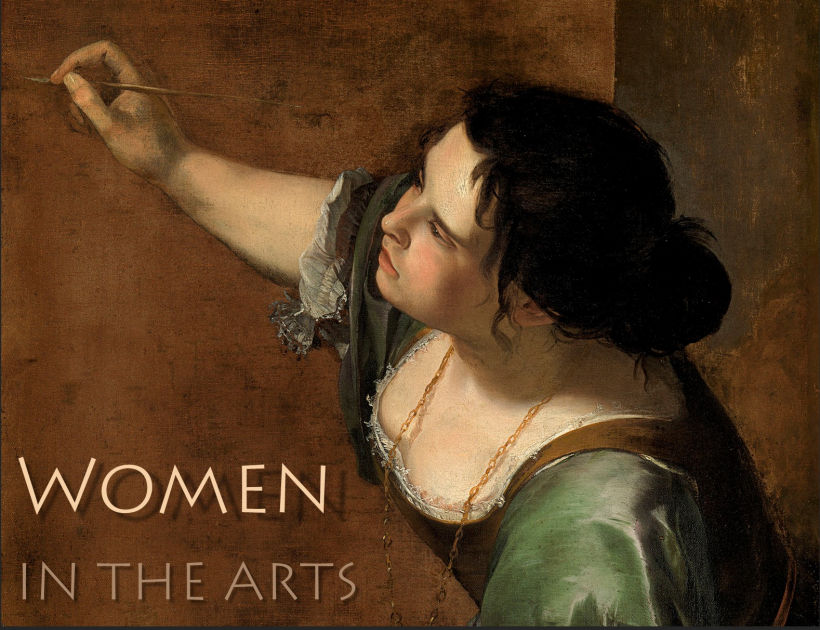9. Group Dynamics
Six groups of artists, formally constituted or otherwise, and six women whose lives intersected with them in
different ways: Marie Bracquemond, Benedetta Cappa, Virginia Woolf, Hannah Höch, Germaine Tailleferre, and Lee
Krasner. A few were founder members; some were grudgingly accepted; all had careers which extended beyond
the duration of the group. [The image above, incidentally, is by Impressionist Berthe Morisot, though I
eventually decided to feature Marie Bracquemond instead.] rb.
The script, videos, and images will be posted immediately after class.
Here are brief bios of the artists, composers, and writers considered in the class, listed in order of birth.
All the specific biographies of women featured in the course are collected in the
BIOS link on the syllabus page.
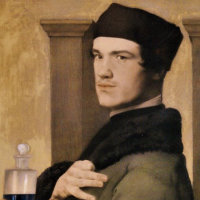 |
Félix Bracquemond, 1833–1914. French artist.
Although he painted a little, Bracquemond was most responsible for a revival of interest in etching during the third quarter of the 19th century in France. He also designed ceramics. His discovery of Hokusai prints wrapping a consignment of imported plates led to the interest in japonisme among his friends the Impressionists. He was the husband of Marie Bracquemond.
|
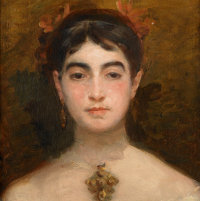 |
Marie Bracquemond, 1840–1916. French painter.
Marie studied with Ingres then worked making official copies at the Louvre. She married Félix Bracquemond in 1869. He taught her engraving, but she found the medium too restricting and fell instead into the orbit of the Impressionists, participating in three of their exhibitions. Most of her paintings have been lost or destroyed, perhaps due to her husband's jealousy.
|
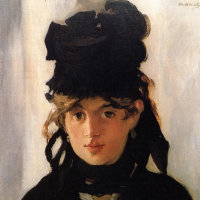 |
Berthe Morisot, 1841–95. French painter.
A descendant of Fragonard, pupil of Corot, sister-in-law of Manet, and later member of the Impressionist group, she brought a fine sensibility to her mainly domestic subjects painted in her characteristic limpid style. Some of her landscapes, however, could be as strong as any of her male colleagues. The portrait is by Manet.
|
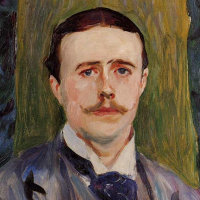 |
Jacques-Émile Blanche, 1861–1942. French painter.
Largely self-taught, Blanche became a successful portrait painter in both Paris and London from the turn of the century on, painting subjects like James Joyce, Aubrey Beardsley, and Marcel Proust.
|
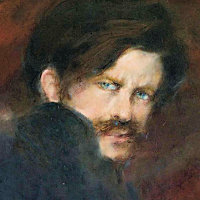 |
Giacomo Balla, 1871–1958. Italian painter.
After achieving some success in mainstream art, Balla joined the Futurist movement in 1909, painting such iconic works as Dynamism of a Dog on a Leash (1912), and designing clothing and furniture.
|
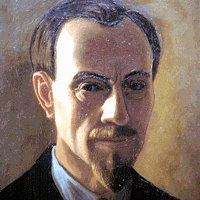 |
Filippo Tommaso Marinetti, 1876–1944. Italian writer and painter.
Poet, theoretician, painter, and performer, Marinetti launched the Futurist movement in 1909 to celebrate the noise, speed, and violence of modern life. The image is his self-portrait.
|
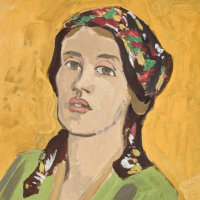 |
Vanessa Bell, 1876–1961. English painter.
The elder sister of Virginia Woolf (née Stephen), Bell was also a member of the Bloomsbury Group, the wife of art critic Clive Bell, and lover of Duncan Grant and Roger Fry. She painted in a mildly Modernist style characterized by simplified forms and lucid color. The image here is a self-portrait.
|
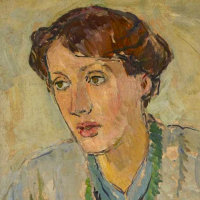 |
Virginia Woolf, 1882–1941. English novelist.
"Virginia Woolf (née Stephen) is considered one of the most important modernist 20th-century authors and a pioneer in the use of stream of consciousness as a narrative device." [Wikipedia] Most of her novels, which include Mrs Dalloway (1925) and To the Lighthouse (1927), were published by the Hogarth Press, which she founded with her husband, the philosopher Leonard Woolf. Together with her sister, painter Vanessa Bell, the three were core members of the Bloomsbury Group. She suffered from bipolar disorder most of her life, and drowned herself at the age of 59.
|
 |
Carlo Carrà, 1883–1966. Italian painter.
Carrà was born in Piedmont and worked as a decorator before studying fine art. He was associated with two notable Italian movements: Futurism and the stile metafisica that he founded with Giorgio di Chirico. In the 1920s, he became more classical, emulating the clear forms of early Renaissance art.
|
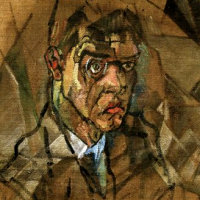 |
Raoul Hausmann, 1886–1971. Austrian artist and writer.
Born in Berlin, he moved with his parents to Berlin in 1901. He became a leading figure in the Berlin Dada group, helping organize their first show in 1920, and contributing to their literary magazine. His experiments with photography led to the simultaneous development of photmontage with his then lover Hannah Höch, although it was she who would develop it as her primary medium.
|
 |
Marc Chagall, 1887–1985. Russian-French painter.
Living in Paris before WW1, and in Russia during it, Chagall mingled with the most innovative artists of the time, but though he learned from them, he quickly developed his own colorful style and personal iconography. These he continued for the rest of his life, working in France, with a wartime sojourn in New York. The main spurs to his creativity in later years were Jewish themes and music.
|
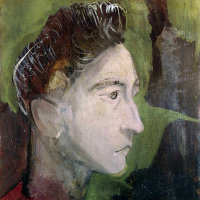 |
Jean Cocteau, 1889–1963. French writer, artist, and filmmaker.
Cocteau's influence on the arts in France in the earlier 20th century was pervasive, extending to most media. In terms only of classical myth, he wrote the text to Stravinsky's Oedipus Rex in 1927 and directed a trio of films based on the Orpheus legend in 1930, 1950, and 1960.
|
 |
Hanna Höch, 1889–1978. German artist.
Höch was a leading Dada artist and one of the inventors of photomontage. Much of her work had a political or social agenda, and often concerned the changing roles of women during the interwar era.
|
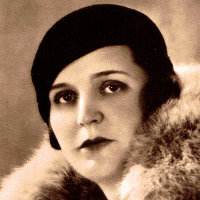 |
Germaine Tailleferre, 1892–1983. French composer.
Tailleferre was the only female member of Les Six, a group of young French composers (Auric, Durey, Honegger, Milhaud, Poulenc, and herself) who came to prominence in the 1920s. Although spending two extended periods in the US, she continued composing and teaching in France to the end of her long life.
|
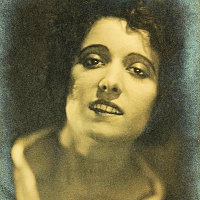 |
Benedetta Cappa, 1897–1977. Italian painter.
Cappa fell under the spell of Filippo Tommaso Marinetti and married him in 1923. Although accepted by the other Futurists with some reluctance, she adapted her style accordingly and remained in the movement to transform it gradually from within.
|
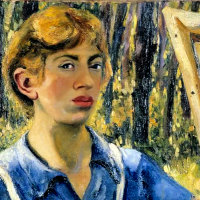 |
Lee Krasner, 1908–84. American painter.
The strong color and design of Krasner's artworks, which combine painting and collage, have since earned her recognition as one of the major figures in the Abstract Expressionist movement, but between 1945 and his death in 1956, she remained somewhat in the shadow of her husband, Jackson Pollock—a complex relationship, but largely a mutually sustaining one.
|
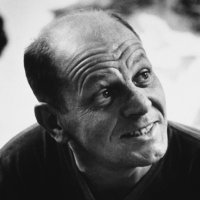 |
Jackson Pollock, 1912–56. American painter.
For many people, Jackson Pollock's "drip paintings," created by pouring paint directly onto raw canvas attached to the studio floor, are the defining image of Abstract Expressionism, and certainly the source of the alternative description, "Action Painting." But Pollock, who was born in Wyoming, studied with Thomas Hart Benton, and worked in the WPA project of the 1930s, reached this style only through a long process of moving through a kind of semi-abstract surrealism.
|
 |
Elaine de Kooning, 1918–89. American painter.
Elaine Fried married Willem de Kooning in 1943, and he became her teacher. While sharing some Abstract Expressionist qualities with her husband, her own work was mostly figurative, including portraits of John Kennedy and others. Though she tirelessly promoted her husband's work and exhibited under their shared name, she chafed at always being seen in his shadow.
|
 |
Helen Frankenthaler, 1928–2011. American painter.
A second-generation Abstract Expressionist, she was the first to develop the technique of pouring thin paint onto unprimed canvas, greatly influencing several of her better-known contemporaries.
|
















































